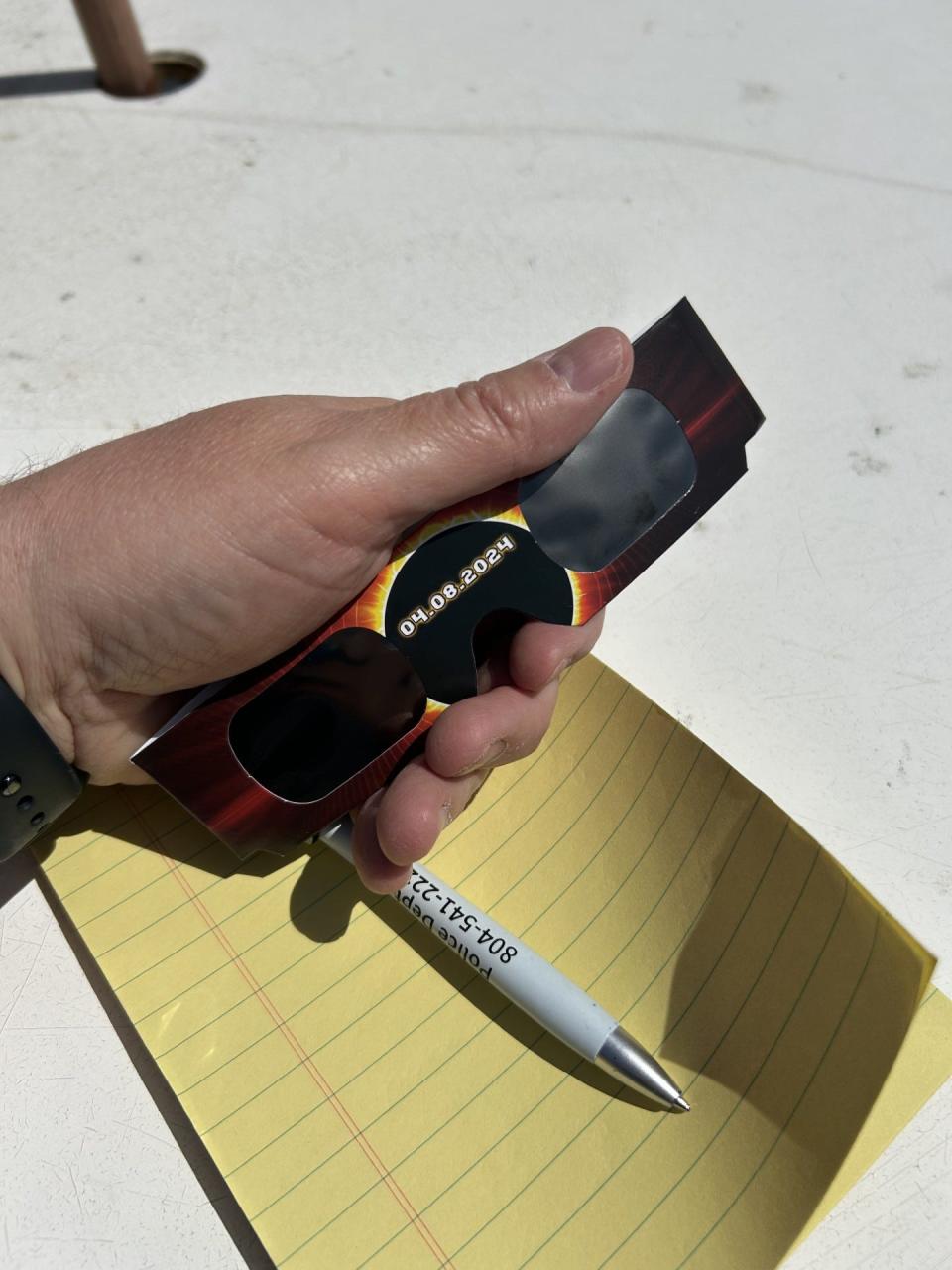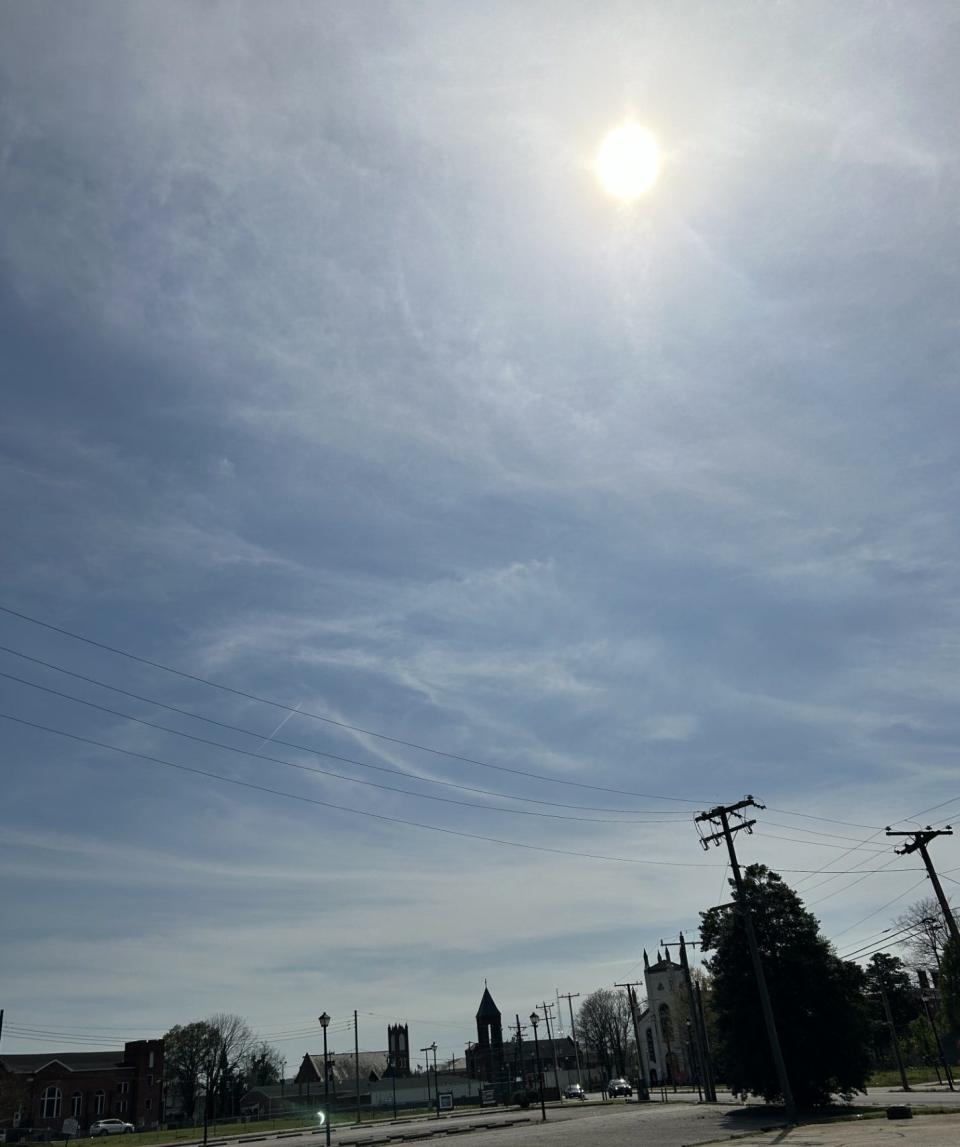The sun eclipses over the Tri-City area, but with very little fanfare, even less darkness
PETERSBURG – Solar Eclipse 2024 is now in the history books, but if you live in the Tri-City area, you probably did not notice much of a difference between Monday afternoon and any other day.
That’s because central Virginia was east of what was called the “totality zone” – a 115-mile swath from the southwestern United States up to northern New England and Canada. Cities such as Dallas, Indianapolis and Cleveland were plunged into total darkness during the four-minute peak time of the total eclipse.
Places on either side of that path – such as Virginia, the Mid-Atlantic and the South – only got a partial peek at the celestial event. In the Tri-City area, we were predicted to see about 86% of the eclipse. That was not enough to put us in the dark ... instead it was more like a high cloudy day.
With that in mind, The Progress-Index stationed itself for a clear (and properly protected) view of our sky at the “triangle” on Halifax Street in downtown Petersburg. Here is the eclipse timeline as we logged it:

1:49 p.m. We set up shop in the Halifax Street triangle. With solar-eclipse glasses in one hand and a notebook in the other, we are ready to document history. It was amazing how breezy the day was, as the grassy umbrella beside us whispered quite a lot during the stay.
2:01 p.m. The official start time of the eclipse. With our glasses, we took a quick look to see what the sun was looking like. It looked like ... the sun. The solar-eclipse glasses were weird at first. You put them on and look around, and you cannot see anything on the ground. So, you look skyward and hunt for the only light visible through them. The game-time temperature is 72 degrees.
2:11 p.m. Ten minutes in, and no celestial activity ... yet.
2:14 p.m. A short glance through the glasses shows the moon start to take its first bite of the apple that is the sun. Not much, but it is a start.
2:21 p.m. The bite gets bigger. In the meantime, there are no visible signs of change on the ground. Cars make their way up and down Halifax Street just like it was another day.
2:35 p.m. The edge of the moon has really come into play now. Through the glasses, it looks like a black dot starting to make its way across. The breeze has picked up, but the temperature is still at 72 degrees.
2:40 p.m. The sunlight does not feel as intense as at first. Shadows cast by utility poles around the triangle look like they got a little longer. The paved parking lot next to the triangle has taken on a slightly gray color, and the bright hues from a sidewalk mural do not seem as crisp as before.
2:45 p.m. Through the glasses, the sun looks like a fat crescent moon. The breeze picks up, but the temperature stays the same roughly 30 minutes before peak time.
2:48 p.m. Thirty minutes to peak time, and the sun’s crescent gets thinner.
2:50 p.m. The siren of a fire engine pierces the air as the truck leaves the Market Street Station and heads west on Halifax Street. The light has dimmed some, now looking like an unseen something was casting a slight shadow over the city.
3 p.m. Eighteen minutes to peak time, and the sun is now basically a sliver of light.
3:06 p.m. The sun now looks like a perfectly upright crescent moon, but its reflection off the tempered glass of a nearby iPhone still looks like a fully engulfed sun in the sky.
3:13 p.m. Five minutes to peak time, and the sun appears through the glasses to be 85% covered – which was what forecasters were saying we’d see.
3:18 p.m. Peak time. No change.

3:25 p.m. We pack up and head to the car. Driving around town, we see scattered small groups of people looking up at the sky through their glasses. A couple of guys sling tripods over their shoulders as if they were trying to capture the moment for posterity.
3:35 p.m. At another stop in downtown Petersburg, we look through the glasses and notice the moon is quickly scooting away.
3:42 p.m. At yet another stop, we take a quick look and see the sun continue to get rounder through the glasses.
4:05 p.m. The moon is almost gone. The sunlight is brighter.
4:31 p.m. The solar eclipse is history ... and so are we.
Bill Atkinson (he/him/his) is an award-winning journalist who covers breaking news, government and politics. Reach him at batkinson@progress-index.com or on X (formerly known as Twitter) at @BAtkinson_PI.
This article originally appeared on The Progress-Index: The P-I chronicles the solar eclipse as seen through Petersburg glasses

 Yahoo News
Yahoo News 
